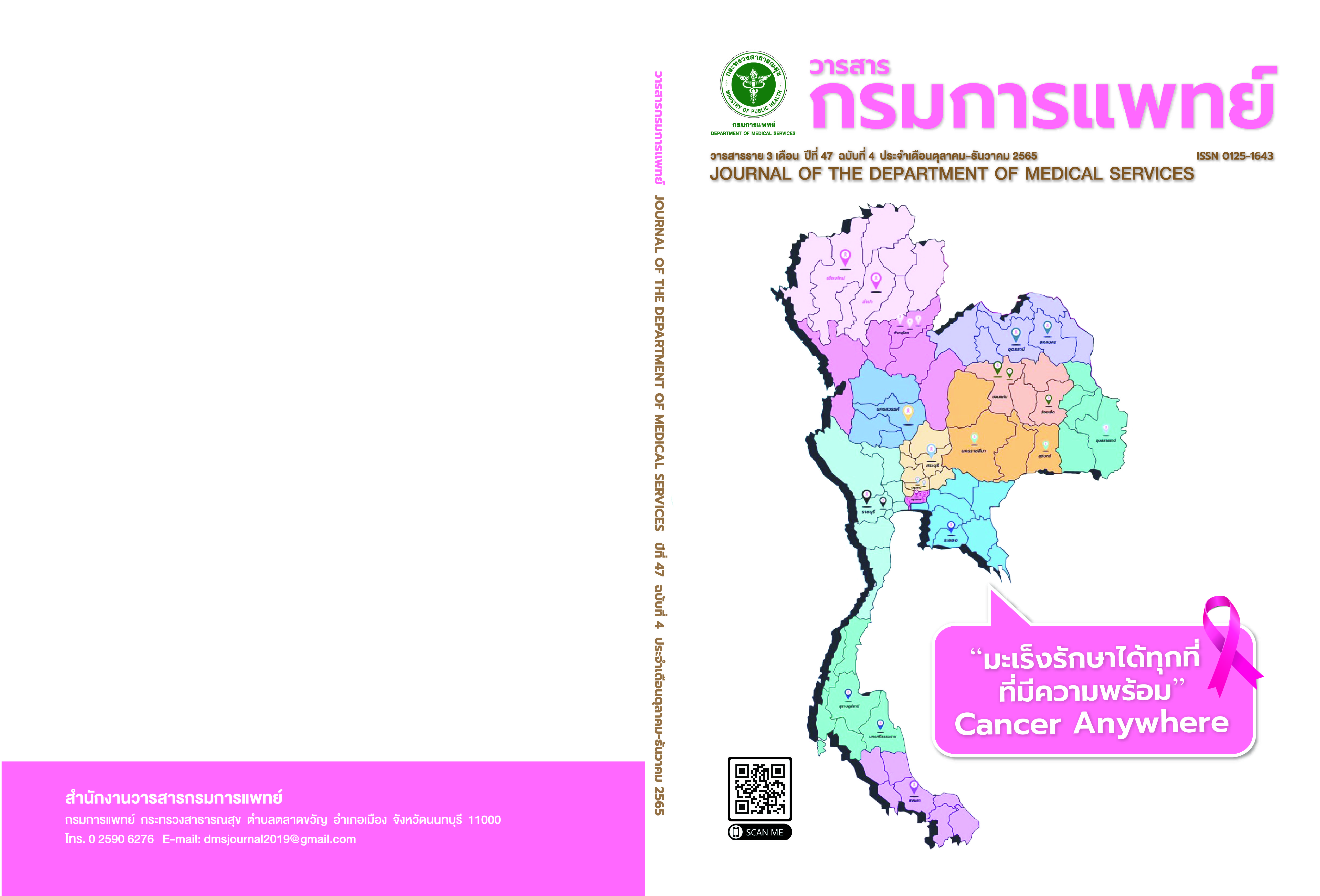Prevalence, Factors and Behaviors Associated with Pressure Injuries in The Independent Wheelchair Using Patients with Spinal Cord Injury
Keywords:
Spinal cord injuries, wheelchairs, pressure ulcer, risk factorsAbstract
Background: Pressure injuries (PrIs) are a common complication following a spinal cord injury (SCI). Objective: This research aims to study the prevalence and factors associated with pressure injuries (PrIs) in spinal cord-injuredpatients with independent wheelchair use. Method: This study was cross-sectional descriptive conducted onseventy-five spinal cord-injured patients with independent wheelchair use. Patients who had PrIs before independentwheelchair used and still have PrIs were excluded. A questionnaire regarding patients’ demographics, history ofPrIs, and risk factors e.g., sitting duration, PrIs knowledge, and protective behaviors was conducted. Possible PrIsrisk factors were compared between patients with and without current PrIs. Result: Among 75 patients, 72 haveparaplegia (96%) and 3 have tetraplegia (4%). The Prevalence of PrIs is 29.3% (95% CI = 18.8, 39.9). 10.7% hadhealed PrIs and 60% never had PrIs. The most common areas of PrIs are ischial tuberosity (55%) and coccyx orsacrum (23%). The causes of the latest incidence of PrIs are friction and shear force while transferring (32%) andprolonged sitting (27%). The risk of PrIs in patients was 5 times greater in the patients who don’t have a regularconcern about friction and shearing force while transferring than those who do (OR5, 95% CI 1.28, 20). Conclusion: PrIs are a common complication found in SCI patients who can transfer independently with a wheelchair. Theprevalence of PrIs in this study was 29.3%. The friction and shear force from careless transferring is a significantfactor that increases the risk of PrIs.
References
Organization WH, Society ISC. International perspectives onspinal cord injury. World Health Organization; 2013. 250.
Blanes L, Lourenço L, Carmagnani MIS, Ferreira LM. Clinical andsocio-demographic characteristics of persons with traumaticparaplegia living in São Paulo, Brazil. Arq Neuropsiquiatr. 2009;67:388–90.
Deconinck H. The health condition of spinal cord injuries in twoAfghan towns. Spinal Cord. 2003; 41:303–9.
Hu X, Zhang X, Gosney J, Reinhardt J, Chen S, Jin H, et al. Analysisof functional status, quality of life and community integration inearthquake survivors with spinal cord injury at hospital dischargeand one-year follow-up in the community. J Rehabil Med. 2012;44:200–5
Kovindha A, Kammuang-lue P, Prakongsai P, Wongphan T.Prevalence of pressure ulcers in Thai wheelchair users withchronic spinal cord injuries. Spinal Cord. 2015; 53:767–71.
Wannapakhe J, Arrayawichanon P, Saengsuwan J, Amatachaya S.Medical complications and falls in patients with spinal cord injuryduring the immediate phase after completing a rehabilitationprogram. J Spinal Cord Med. 2015; 38:84–90.
Zakrasek EC, Creasey G, Crew JD. Pressure ulcers in peoplewith spinal cord injury in developing nations. Spinal Cord. 2015;53:7–13.
Lala D, Dumont FS, Leblond J, Houghton PE, Noreau L. Impactof pressure ulcers on individuals living with a spinal cord injury.Arch Phys Med Rehabil. 2014; 95:2312–9.
Chen Y, DeVivo MJ, Jackson AB. Pressure ulcer prevalence inpeople with spinal cord injury: Age-period-duration effects. ArchPhys Med Rehabil. 2005; 86:1208–13.
Garber SL, Rintala DH, Hart KA, Fuhrer MJ. Pressure ulcer risk inspinal cord injury: Predictors of ulcer status over 3 years. ArchPhys Med Rehabil. 2000; 81:465–71.
Correa GI, Fuentes M, Gonzalez X, Cumsille F, Piñeros JL,Finkelstein J. Predictive factors for pressure ulcers in theambulatory stage of spinal cord injury patients. Spinal Cord.2006; 44:734–9.
Rabadi MH, Vincent AS. Do vascular risk factors contribute tothe prevalence of pressure ulcer in veterans with spinal cordinjury? J Spinal Cord Med. 2011; 34:46–51.
Scivoletto G, Fuoco U, Morganti B, Cosentino E, Molinari M.Pressure sores and blood and serum dysmetabolism in spinalcord injury patients. Spinal Cord. 2004; 42:473–476.
Krause JS, Vines CL, Farley TL, Sniezek J, Coker J. An exploratorystudy of pressure ulcers after spinal cord injury: Relationship toprotective behaviors and risk factors. Arch Phys Med Rehabil.2001; 82:107–13.
Smith BM, Guihan M, LaVela SL, Garber SL. Factors predictingpressure ulcers in veterans with spinal cord injuries: Am J PhysMed Rehabil. 2008; 87:750–7.
Guihan M, Garber S, Bombardier C, Goldstein B, Holmes L, CaoS. Predictors of pressure ulcer recurrence in Veterans with spinalcord injury. J Spinal Cord Med. 2008; 31:551–9.
Morita T, Yamada T, Watanabe T, Nagahori E. Lifestyle risk factorsfor pressure ulcers in community-based patients with spinalcord injuries in Japan. Spinal Cord. 2015; 53:476–81.
Consortium for Spinal Cord Medicine, Paralyzed Veterans ofAmerica. Pressure ulcer prevention and treatment followingspinal cord injury: a clinical practice guideline for health-careproviders. Washington, DC: Consortium for Spinal Cord Medicine;2014.
Wilekha N, Kovindha A. A study of protective behaviors and riskfactors of pressure ulcers in spinal cord injured patients. J ThaiRehabil. 2005; 15:101–12.
Edsberg LE, Black JM, Goldberg M, McNichol L, Moore L, SieggreenM. Revised National Pressure Ulcer Advisory Panel PressureInjury Staging System: Revised Pressure Injury Staging System. JWound Ostomy Continence Nurs. 2016; 43:585–97.
Eslami V, Saadat S, Habibi Arejan R, Vaccaro AR, Ghodsi SM,Rahimi-Movaghar V. Factors associated with the developmentof pressure ulcers after spinal cord injury. Spinal Cord. 2012;50:899–903.
Sonenblum SE, Sprigle SH. Some people move it, move it… forpressure injury prevention. J Spinal Cord Med. 2018; 41:106–10.
Downloads
Published
How to Cite
Issue
Section
License
Copyright (c) 2022 Department of Medical Services, Ministry of Public Health

This work is licensed under a Creative Commons Attribution-NonCommercial-NoDerivatives 4.0 International License.
บทความที่ได้รับการตีพิมพ์เป็นลิขสิทธิ์ของกรมการแพทย์ กระทรวงสาธารณสุข
ข้อความและข้อคิดเห็นต่างๆ เป็นของผู้เขียนบทความ ไม่ใช่ความเห็นของกองบรรณาธิการหรือของวารสารกรมการแพทย์



